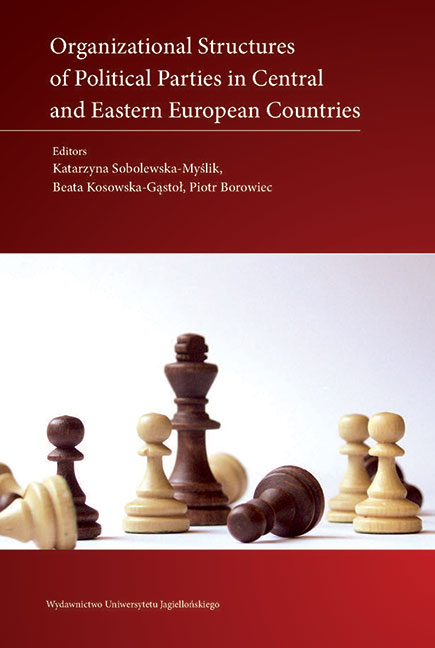Book contents
- Frontmatter
- Contents
- Preface
- Developing Party Structures in Central and Eastern Europe
- Albania: Organizations of Political Parties in Albania
- Belarus: Belarusian Political Parties: Organizational Structures and Practices
- Bosnia and Herzegovina: Organizational Structures of Political Parties in CEE Countries: A Case Study on Bosnia and Herzegovina
- Bulgaria: Organizational Structure and Trends in Bulgarian Party Politics
- Croatia: Organizational Structures of Political Parties in Croatia
- Czech Republic: Between Organizational Extremes: Czech Parties after a Political Earthquake
- Estonia: Organizational Structures of Political Parties in Estonia
- Hungary: Cut from the Same Cloth? A Comparative Analysis of Party Organizations in Hungary
- Kosovo: Structure of the Main Political Parties in Kosovo
- Latvia: Leader-Centered and Power-Hungry: Party Organizations in Latvia
- Lithuania: Organization of Political Parties: The Case of Lithuania
- Moldova: Organizational Structures of Political Parties in The Republic of Moldova
- Montenegro: Party Organization in Montenegro: Structural Resemblance Behind Political Divergence
- Poland: Structures of Polish Political Parties in the Second Decade of the 21st Century
- Romania: The Internal Organization of Romanian Political Parties
- Russia: Parties with Roots Growing Upwards: Organizational Features of Russian Political Parties
- Serbia: Organizational Structures of Political Parties in Serbia
- Slovakia: Organizational Structures of Political Parties in Slovakia: Parties not for Members
- Slovenia: Almost without Any Innovations: Organizational Structures in Slovenian Parties
- Ukraine: Shallow Party Structures in a Volatile Party System
- Comparing Organizational Structures of Political Parties in Central and Eastern European Countries
- Biographical notes about the authors
Serbia: Organizational Structures of Political Parties in Serbia
- Frontmatter
- Contents
- Preface
- Developing Party Structures in Central and Eastern Europe
- Albania: Organizations of Political Parties in Albania
- Belarus: Belarusian Political Parties: Organizational Structures and Practices
- Bosnia and Herzegovina: Organizational Structures of Political Parties in CEE Countries: A Case Study on Bosnia and Herzegovina
- Bulgaria: Organizational Structure and Trends in Bulgarian Party Politics
- Croatia: Organizational Structures of Political Parties in Croatia
- Czech Republic: Between Organizational Extremes: Czech Parties after a Political Earthquake
- Estonia: Organizational Structures of Political Parties in Estonia
- Hungary: Cut from the Same Cloth? A Comparative Analysis of Party Organizations in Hungary
- Kosovo: Structure of the Main Political Parties in Kosovo
- Latvia: Leader-Centered and Power-Hungry: Party Organizations in Latvia
- Lithuania: Organization of Political Parties: The Case of Lithuania
- Moldova: Organizational Structures of Political Parties in The Republic of Moldova
- Montenegro: Party Organization in Montenegro: Structural Resemblance Behind Political Divergence
- Poland: Structures of Polish Political Parties in the Second Decade of the 21st Century
- Romania: The Internal Organization of Romanian Political Parties
- Russia: Parties with Roots Growing Upwards: Organizational Features of Russian Political Parties
- Serbia: Organizational Structures of Political Parties in Serbia
- Slovakia: Organizational Structures of Political Parties in Slovakia: Parties not for Members
- Slovenia: Almost without Any Innovations: Organizational Structures in Slovenian Parties
- Ukraine: Shallow Party Structures in a Volatile Party System
- Comparing Organizational Structures of Political Parties in Central and Eastern European Countries
- Biographical notes about the authors
Summary
Introduction
In this chapter we will focus on Serbian political parties and their organizational structures. Our analysis will be driven by the notion that political parties are one of the few influential political actors or institutions that are functional in contemporary Serbia without real counterweight in civil society or any other social or political institutions. Despite a high level of party membership, political participation and trust in political parties is low.
This analysis will also provide insight into the legal framework set by political parties and their tendency towards concentration of power and cartelization. We will, therefore, start with legal documents (laws, statutes, internal procedural documents), and provide contextual insight based on previous research whenever possible in order to explain the mechanism of power-sharing within parties and its consequences for the democratization of Serbia.
In our analysis, we will focus on the Socialist Party of Serbia (SPS – Socijalistička partija Srbije), and the Democratic Party (DS – Demokratska stranka), as they represent the only two relevant national parties that have been in operation since the fi rst democratic elections in 1990. Although the Serbian Progressive Party (SNS – Srpska napredna stranka) has been the strongest party by far in recent years (2012–2016), it is still a young party based primarily on the popularity of its leader and is yet without an established party structure. Due to their political importance and relatively long existence, DS and SPS have the most developed programmatic and organizational structures. Finally, several parties from the liberal and modernist block can be traced back to the Democratic Party (either official factions or unofficial groups that once belonged to DS).
Political Developments in Serbia since the Fall of Communism in Yugoslavia
The Serbian transition took place in two phases and is similar to that of some other Central and Eastern European countries (e.g. Romania and Bulgaria), in which a somewhat transformed communist party won the first partially democratic elections (Kasapović 1996). This left an important mark on the transition that would afterwards ensue. Furthermore, the Serbian case involved the breakup of Yugoslavia. Serbia is not unique among post-communist or post-Yugoslav fragile democracies, yet it must be analyzed with specific scrutiny against the usual paradigms and analytical models.
- Type
- Chapter
- Information
- Organizational Structures of Political Parties in Central and Eastern European Countries , pp. 369 - 390Publisher: Jagiellonian University PressPrint publication year: 2017



